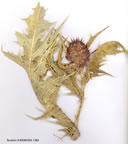| Asteraceae |
 Gundelia tournefortii var. armata |
| Gundelia L. Gundelia tournefortii L. var. armata FREYN ET SINT. Ömür: Çok yıllık Yapı: ot Hayat formu: İlk çiçeklenme zamanı: 5 Son çiçeklenme zamanı: 6 Habitat: kayalık kireçtaşı yamaç, volkanik yamaç, step, tuzlu göl yakını, orman açıklığı, nadas tarla Minimum yükseklik: 1000 Maksimum yükseklik: 2000 Endemik: - Element: İran-Turan Türkiye dağılımı: Karasal Anadolu, G. Anadolu Genel dağılımı: Transkafkasya, Kıbrıs, B. Suriye, Suriye Çöl, K. Irak, İran, Transhazar Bulunduğu kareler :A4 A8 B3 B4 B5 B6 B7 B8 B9 C2 C3 C4 C5 C6 C7 C9 C10 |
| G. tournefortii L., Sp. Pl. 814 (1753). K. Karamanoğlu in Türk Biol. Derg. 14:5-9 (1964). Figure 1, p. 3; figure 2, p. 9. Map 36, p. 359. Plant 20-100 cm. Stems erect, branched, often shining, glabrous or sparsely arachnoid. Leaves rigid, glabrous or arachnoid, with prominent nerves, lanceolate-in outline, sessile or base decurrent into spiny stem-wings, pinnatifid to sub-2-pinnatisect, with spiny-dentate margins; lower leaves 7-30x4.5-16 cm, those above decreasing in size. Heads solitary, 2-5 x 2-4 cm excl. bracts. Bracts spiny-margined, ovate-acuminate and scarcely exceeding capitula or apex prolonged into a hard subterete or flattened spine up to 7 cm. Capitulum 7-17 mm long, incl. exserted corollas. Flowers c. 4-8. Capitula at time of dispersal obovoid to tetragonal, 10-16x5-9 mm. Fertile achene smooth, ovoid. Fl. 5-6. Rocky limestone & igneous slopes, steppe, nr salt lakes, open woodland, fallow fields, 100-2500 m. 1. Bracts greatly exceeding flowers, with apex prolonged into (1 .5-)2.5-7 cm spine; leaves pinnatifid var. armata 1. Bracts not or only slightly exceeding flowers, apical spine less than 1.5 cm 2. Leaves sub-2-pinnatisect, divided almost to rachis; primary segments narrowly triangular, finely spiny var. tenuisecta 2. Leaves pinnatifid; segments broadly triangular, coarsely spiny var. tournefortii var. armata Freyn & Sint. in Öst. Bot. Zeitschr. 42:168 (1892). Type: [Turkey B7 Erzincan] Egin (Kemaliye) in monte Hodschradur-Dagh, 3 vi 1890, Sintenis 2577 (iso. LD!). Inner & S. Anatolia. B5 Nevşehir: 70 km W. of Kayseri, 1200 m, Sorger 64-22-26! B9 Bitlis: Tatvan, 1990 m, Tong 84! C5 Adana: E. of Gülek Boğazi, 2000 m, Sorger 62-71-40! C6 Gaziantep: Kefre nr Birecik, Sint. 1888:607! Maraş: Ahir Da., 1000 m, Balls 972! C7 Diyarbakır: Karacadağ, 1490 m, E.S.Brown 623! The following specimens are intermediate between var. tenuisecta and var. armata, having both sub-2-pinnatisect leaves and long-spined bracts. B6 Malatya: Doğanşehir, 1400 m, Stn. & Hend. 5477! B7 Erzincan: Sandik nr Egin (Kemaliye), Sint. 1890:2429! C6 Maraş: Maraş to Göksun, nr Yemiş Da., 600 m, D. 27512! Gundelia tournefortii s.l. has also been recorded from the following localities: A3 Ankara: Beypazarı, Karamanoğlu (op. cit. p. 5); Bl Izmir: Aliağa, Kara-manoğlu (op. cit. p. 5); C7 Adiyaman: Nemrut Da. nr Kahta, Hand.-Mazz. External distribution of species: Transcaucasia, Cyprus, W. Syria, Syrian Desert, N. Iraq, Iran (except S,), Transcaspia. Ir.-Tur. element. A tumbleweed. The species is collected and dried in summer, being stacked for winter fodder on the Anatolian plateau. A chewing-gum (called 'kenger sakizi') is made from the latex, and the seeds are used as coffee ('kenger kahvesi') after torrefaction. See Karamanoğlu, op. cit. lobes often long and sometimes unequal, or heterogamous and disciform with marginal flowers female or neuter, often radiant, rarely ligulate. Involucre cartilaginous or scarious; phyllaries imbricate, pluriseriate. Receptacle usually paleaceous or bearing long bristles or hairs. Flowers yellow or purplish, less commonly white. Style slightly thickened or with a ring of minute hairs near point of bifurcation. Anther bases mostly tailed. Achenes ± terete or compressed, unbeaked, or often with an umbo in the Carduineae. Pappus scaly, bristly or hairy. Figure 1, p. 3. Tribe mainly Eurasian, chiefly Mediterranean and S.W. to C. Asian. Several segregate genera have been recognized recently, chiefly on the basis of detailed studies of achene morphology (Dittrich in Willdenowia 5:67-107, 1968, and Candollea 25:45-67, 1970). The East European splitting of Centaurea, however, has not been adopted here. The fleshy receptacles of Cynara scolymus L. (globe artichoke) are eaten. The flowers of Carthamus tinctorius L. yield a red dye and their achenes an oil. |